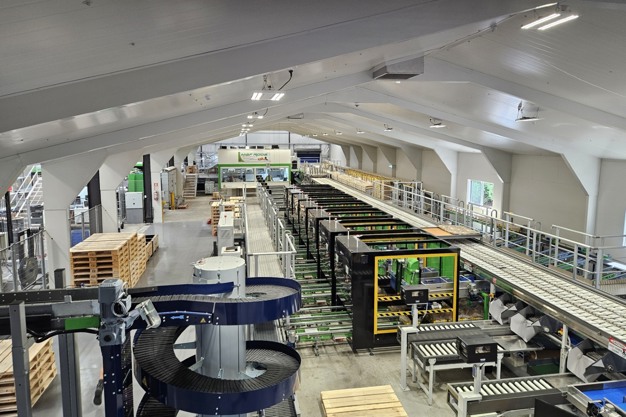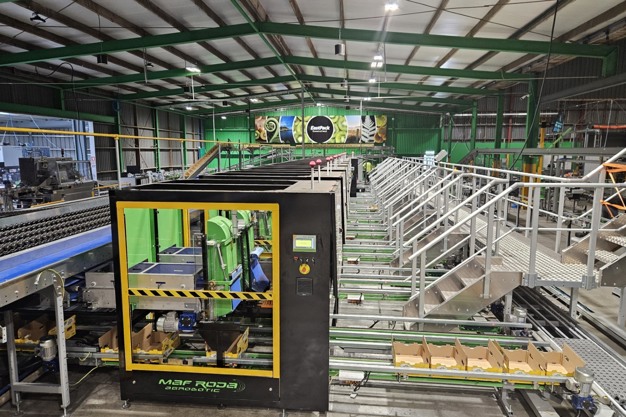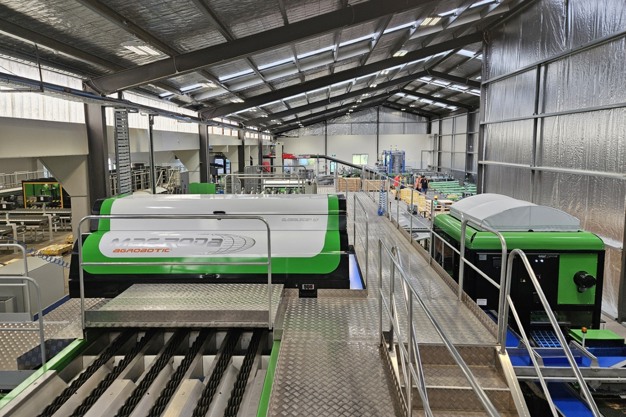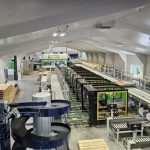MAF Roda NZ has been consistently active in the New Zealand market since 2016 and has sold equipment year after year since then.
“MAF Roda Agrobotic is a multinational engineering company committed to providing the most innovative and high-end solutions for automation, grading, sorting, and packing in the fresh fruit and vegetables industry,” said Chris Bray at MAF Roda NZ.
“Our universal technology is completely manufactured in-house, providing an integral solution, from infeed to palletizing, including electronic sorting, grading and automatic packing, that increase the performance and production of our customer’s facilities and simplify the decision making process. Our most ambitious systems use AI and big data to provide the most accurate internal and external analysis –including color, shape, diameter and weight–, increasing the quality of the end product.”

In the last five years, MAF Roda NZ has been very successful in the kiwifruit industry and this season alone had various projects across 12 kiwifruit packhouses in New Zealand.
“We have 30 sizers to grade and pack already in place within the kiwifruit sector, and we have added equipment like our Robotic tray packers to non-MAF sizers and our closer, printer, stacker (CPS) solution.”
MAF Roda NZ also has apple lines, avocado lines, stone fruit, cherry, and citrus lines in New Zealand and has also automated a blueberry infeed line to add efficiencies and solve labour challenges.
“Many of our projects are turnkey solutions, providing end-to-end solutions; thus, the customer engages only one supplier and does not have many suppliers providing various pieces of equipment. Only MAF Roda can provide this in the New Zealand market, from bin handling equipment to palletisation of packed products. This ease of integration and design means customers only need to deal with one company, giving them better control over project timelines and eliminating any potential hiccups.
“By being a proven global supplier, including a robust traceability system means our customers don’t need to work with many suppliers for their project. We gather information, understand the customers’ business, their constraints, and what they would like to achieve, and design a line to provide solutions. We manufacture the equipment in Europe to high standards, manage the shipping, and have our team install the equipment. Our in-house Automation team programmes the line and carries out the commissioning, so customers deal directly with our team rather than overseas people or contractors, which gives them a more personalised relationship.
“In the last 3 years, we have retrofitted non MAF Roda sizers, this enables the customer to have access to our software, automation and traceability solutions as well as MAF Roda packing equipment to assist them.”

Robotics and AI
“We continue to make great advancements in our camera grading system (Globalscan 7) that now incorporates AI machine model learning.
“We have been granted a patent for Globalscan 7 in many countries, including New Zealand, and as part of our customer service offering bring the software developers from MAF Roda France to New Zealand annually to sit with customers and see how we can better assist them. Having direct access to the developer adds immense value to our customers and enhances the relationships we have with them.”
MAF Roda NZ is placing more and more Robotic IT packers in kiwifruit packhouses, and these also integrate on competitors’ sizers, so this provides them with new customers who then get access to the latest global technology on offer while reducing the dependency on labour and increasing throughput.
“As approximately 80% of exported kiwifruit now goes in boxes, we are seeing an increased demand for our gentle box fillers. Given that we also manufacture conveyors, we can take empty boxes from box makers through a bag-in-box solution, into box fillers, back to box closing, using our traceability systems to print the correct label, and into a palletisation area. In the last three months, we have added 60 box fillers across four customers to assist them, including some on non-MAF Roda Lines.
“In collaboration with MAF France, we are always trying to develop solutions to assist our customers. We have introduced a box/tray closer, printer, stacker (CPS) that is very successful with customers as it improves efficiencies while reducing labour and can handle ten boxes per minute. This equipment is versatile as it can be placed behind our IT Tray robotic packers, our gentle box fillers or on a manual drop, and it has a very small footprint, meaning it can be utilized in any packhouse.
“This season we are trialling a prototype Kiwifruit plix denester and this will reduce labour and improve efficiencies.”

MAF Roda NZ team
Although MAF Roda does not manufacture in New Zealand, they do have 10 manufacturing sites around the world. The majority of the equipment for New Zealand is manufactured in France.
“Our customers prefer a quality-made product, which we manufacture in France. We now have 12 people in our MAF Roda NZ team which mainly consists of mechanical and electrical technicians as well as our own automation team and a technician who looks after our camera grading. This team provides installations as well as 24-hour service and support to all our customers. After sales, service is an important component of our business, so it’s important we have a high service offering.”
For more information:
Chris Bray
MAF Roda NZ
Tel: +61 27 298 4498
[email protected]
